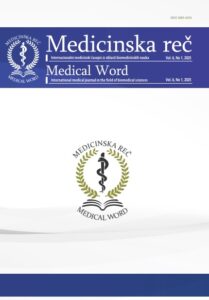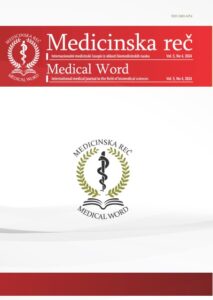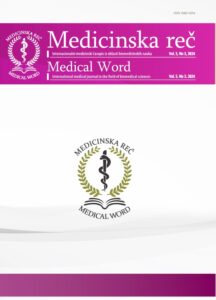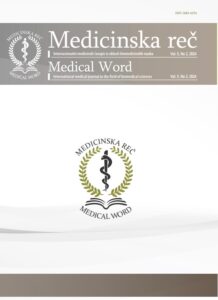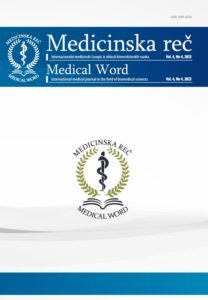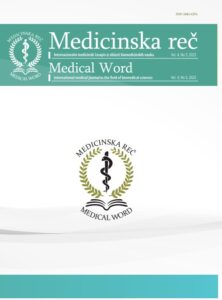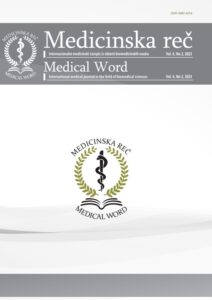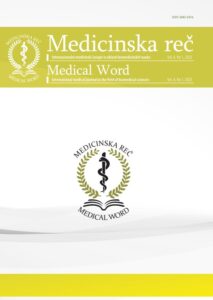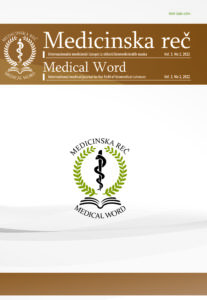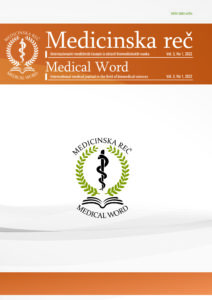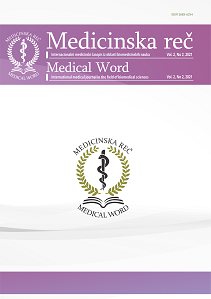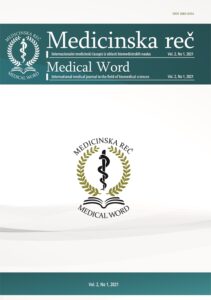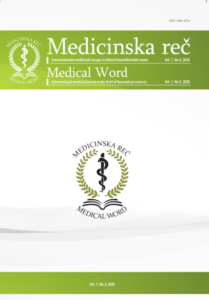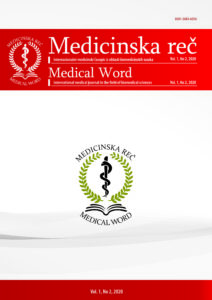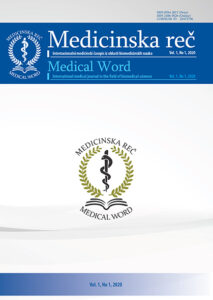Od nukleisanih do ex vivo manipulisanih matičnih ćelija – osavremenjena biološka i klinička sinapsa
Bela Balint, Mirjana Pavlovic, Milena Todorovic
Med reč 2020; 1(1): 1–9
DOI: https://doi.org/10.5937/medrec2001001B
Apstrakt
Hematopoetske matične ćelije (MĆ) odgovorne su za produkciju i obnovu (proliferacija) opsežne količine funkcionalno kompetentnih krvnih ćelija (diferencijacija) tokom celog života, istovremeno one održavaju sposobnost sopstvene reprodukcije (samoobnavljanje). Složena mreža interaktivnih supstanci i faktora organizuje i obezbeđuje preživljavanje, sazrevanje i umnožavanje MĆ.
Hemobiološki događaji u kostnoj srži (KS) sinhronizovani/uravnoteženi su ekstracelularnim matriksom i mikrookolinom koji obezbeđuju stromalne ćelije. Ove ćelije – uključujući makrofage, fibroblaste, dendritske, endotelske i druge ćelije – deluju stimulativno na MĆ, oslobađanjem specifičnih hematopoetskih faktora rasta. Neki drugi citokini koje izlučuju stromalne ćelije regulišu adhezivne molekule iskazane na MĆ, omogućavajući im da ostanu u KS ili da migriraju u područje gde je potreban odgovarajući specifičan tip ćelije. Na taj način, hematopoetske MĆ je moguće definisati kao ćelije visokog proliferativnog kapaciteta i ogromnog potencijala da se diferentuju u sve vrste krvnih ćelija ili u neke somatske ćelije (plastičnost MĆ) – kao što su kardiomiociti, miociti, osteociti, hondrociti, hepatociti, ali i endotelske ćelije.
Sve šira klinička primena ćelijski-posredovanih terapijskih pristupa rezultuje stalno rastućim potrebama u samim MĆ, ali i poboljšanjima operativnih procedura njihove ex vivo manipulacije. Osnovni cilj prikupljanja ćelija je da se dobije veći prinos i vijabilnost ili klonogenost MĆ. Cilj optimizovanih protokola krioistraživanja je da se minimizuju oštećenja ćelija (kriooštećenja). Uprkos činjenici da se različiti protokoli za prikupljanje i protokoli kriokonzervacije MĆ su već u rutinskoj upotrebi, brojna pitanja vezana za optimalne ex vivo manipulaciju MĆ još uvek nisu u potpunosti rešena.
Ovaj revijalni rad prikazuje osnovna saznanja i metodološke pristupe, kao i podatke koji omogućavaju napredak na stalno razvijajućim frontovima istraživanja na području MĆ. Studije (uključujući i naša istraživanja) koje procenjuju efikasnost i sigurnost terapijske primene MĆ (transplantacijska i regenerativna medicina) biće takođe ukratko predstavljene.
Ključne reči: matične ćelije, transplantacija, regenerativna medicina
Literatura
- Balint B. Stem and progenitor cell harvesting, extracorporeal “graft engineering” and clinical use – initial expansion vs. current dillemas. Clin Appl Immunol 2006; 5(1): 518–27.
- Pavlovic M, Balint B. Bioengineering and cancer stem cell concept. New York: Springer; 2015.
- Pavlovic M, Balint B. Stem Cells and Tissue Engineering. New York: Springer; 2013.
- Balint B. Matične ćelije – hemobiologija i transfuziološki pristupi. U: Kovac M, Balint B, Bogdanovic G (Urednici). Bazična i klinička transfuzija. Beograd: Medicinski fakultet; 2020. pp. 509–25.
- Balint B, Obradovic S, Todorovic M, Pavlovic M, Mihaljevic B. Stem cell–based (auto)grafting: from innovative research toward clinical use in regenerative medicine. In: Alimoghaddam K, editor. Stem Cell Biology in Normal Life and Diseases. Rijeka: InTech. 2013. p. 111–35.
- Bilko NM, Fehse B, Ostertag W, Stocking C, Zander AR. Stem cells and their potential for clinical application. Dordrecht: Springer; 2008.
- Jiang Y, Zhen Y, Xu Q, He D, Chen G, Chen Y. Bone marrow versus peripheral blood stem cell transplant in lymphoma: A systematic review and meta-analysis. Exp Clin Transplant 2018; 16(5): 596–607.
- Balint B, Stanojevic I, Todorovic M, Stamatovic D, Pavlovic M, Vojvodic D. Relative frequency of immature CD34+/CD90+ subset in peripheral blood following mobilization correlates narrowly and inversely with the absolute count of harvested stem cells in multiple myeloma patients. Vojnosanit Pregl 2017; 74(11): 1071–7.
- Balint B, Stamatovic D, Todorovic M, Elez M, Vojvodic D, Pavlovic M, Cucuz–Jokic M. Autologous transplant in aplastic anemia: quantity of CD34+/CD90+ subset as the predictor of clinical outcome. Transf Apher Sci 2011; 45(2): 137–41.
- Balint B, Ljubenov M, Stamatovic D, Todorovic M, Pavlovic M, Ostojic G, et al. Stem cell harvesting protocol research in autologous transplantation setting: large volume vs. conventional cytapheresis Vojnosanit Pregl 2008; 65(7): 545–51.
- Todorovic Balint M, Jelicic J, Bila J, Balint B, Antic D, Trajkovic G , et al. Influence of applied CD34+ cell dose on the survival of Hodgkin’s lymphoma and multiple myeloma patients following autologous stem cell transplants. Vojnosanit Pregl. In Press 2020. DOI: https://doi.org/10.2298/VSP180808160T
- Ahmed Z, Imdad A, Connelly JA, Acra S. Autoimmune enteropathy: An updated review with special focus on stem cell transplant therapy. Dig Dis Sci 2019; 64(3): 643–54.
- Riazi AM1, Kwon SY, Stanford WL. Stem cell sources for regenerative medicine. Methods Mol Biol 2009; 482: 55–90.
- Haseltine WA. Interview: commercial translation of cell-based therapies and regenerative medicine: learning by experience. Interview by Emily Culme-Seymour. Regen Med. 2011; 6(4): 431–5.
- Lee JY, Hong SH. Hematopoietic stem cells and their roles in tissue regeneration. Int J Stem Cells 2019. doi: 10.15283/ijsc19127.
- Balint B, Stamatovic D, Todorovic M, Jevtic M, Ostojic G, Pavlovic M, et al. Stem cells in the arrangement of bone marrow repopulation and regenerative medicine. Vojnosanit Pregl 2007; 64(7): 481–4.
- Gianni-Barrera R, Di Maggio N, Melly L, Burger MG, Mujagic E, Gürke L, et al. Therapeutic vascularization in regenerative medicine: Concise review. Stem Cells Transl Med 2020. doi: 10.1002/sctm.19-0319.
- Cho J, D’Antuono M, Glicksman M, Wang J, Jonklaas J. A review of clinical trials: mesenchymal stem cell transplant therapy in type 1 and type 2 diabetes mellitus. Am J Stem Cells 2018; 7(4): 82–93.
- Chen L, Qu J, Cheng T, Chen X, Xiang C. Menstrual blood-derived stem cells: toward therapeutic mechanisms, novel strategies, and future perspectives in the treatment of diseases. Stem Cell Res Ther 2019; 10(1): 406. doi: 10.1186/s13287-019-1503-7.
- Ratajczak MZ, Zuba-Surma E, Kucia M, Poniewierska A, Suszynska M, Ratajczak J. Pluripotent and multipotent stem cells in aduld tissue. Adv Med Sci 2012; 19: 1–17.
- Kucia M, Zhang YP, Reac R, Wysoczynski M, Machalinski B, Majka M, Ildstad ST, Ratajczak JU, Chields CB, and Ratajczak MZ. Cells enriched in markers of neural tissue–commited stem cells reside in the bone marrow and are mobilized into the peripheral blood following stroke. Leukemia 2006, 20: 18–28.
- Ratajczak MZ, Suszynska M, Pedziwiatr D, Mierzejewska K, Greco NJ. Umbilical cord blood–derived very small embryonic like stem cells (VSELs) as a source of pluripotent stem cells for regenerative medicine. Pediatr Endocrinol Rev 2012; 9: 639–43.
- Kucia M, Reca R, Campbell FR, Surma–Zuba E, Majka M, Ratajczak M, and Ratajczak MZ A population of very small embryonic – like (VSEL) CXR4+SSEA–1+Oct4+ stem cells identified in adult bone marrow. Leukemia 2006, 20: 857–69.
- Mousavi SH, Zarrabi M, Abroun S, Ahmadipanah M, Abbaspanah B. Umbilical cord blood quality and quantity: Collection up to transplantation. Asian J Transfus Sci 2019; 13(2): 79–89.
- Arcuri LJ, Aguiar MTM, Ribeiro AAF, Pacheco AGF. Haploidentical transplantation with post-transplant cyclophosphamide versus unrelated donor hematopoietic stem cell transplantation: A systematic review and meta-analysis. Biol Blood Marrow Transplant 2019; 25(12): 2422–30.
- Mian H, Mian OS, Rochwerg B, Foley R, Wildes TM. Autologous stem cell transplant in older patients (age ≥ 65) with newly diagnosed multiple myeloma: A systematic review and meta-analysis. J Geriatr Oncol 2020; 11(1): 93–9.
- Lindwall O, Kokaia Z, Martinez–Serrano A. SCs for the treatment of neurological disorders. Nature 2006; 441: 1094–6.
- Das J, Sharrack B, Snowden JA. Autologous haematopoietic stem cell transplantation in multiple sclerosis: a review of current literature and future directions for transplant Haematologists and Oncologists. Curr Hematol Malig Rep 2019; 14(2): 127–35.
- Skoric D, Balint B, Petakov M, Sindjic M, Rodic P. Collection strategies and cryopreservation of umbilical cord blood. Transfusion Medicine 2007; 17(2): 107–13.
- Balint B, Ivanovic Z, Petakov M, Taseski J, Jovcic G, Stojanovic N, et al. The cryopreservation protocol optimal for progenitor recovery is not optimal for preservation of MRA. Bone Marrow Transpl 1999; 23: 613–9.
- Beltrami AP, Urbanek K, Kajstura J, Yan S–M, Finato N, Bussani R et al. Evidence that human cardiac myocites divide after myocardial infarction. N Engl J Med 2001; 344(23): 1750–7.
- Shintani S, Murohara T, Ikeda H, Uenoi T, Honma T, Katoh A, et al. Mobilization of endothelial progenitor cells in patients with acute myocardial infarction. Circulation 2001; 103: 2776–9.
- Strauer BE, Brehm M, Zeus T, Köstering M, Hernandez A, Sorg RV. Repair of infarcted myocardium by autologous intracoronary mononuclear bone marrow cell transplantation in humans. Circulation 2002; 106(15): 1913-8.
- Hassink RJ, de la Rivere AB, Mummery CL, Doevendans PA. Transplantation of cells for cardiac repair. J Am Coll Cardiol 2003; 41(5): 771–7.
- Kishino Y, Fujita J, Tohyama S, Okada M, Tanosaki S, Someya S, et al. Toward the realization of cardiac regenerative medicine using pluripotent stem cells. Inflamm Regen 2020; 40:1. doi: 10.1186/s41232-019-0110-4.
- Balint B, Kanjuh V, Ostojić M, Obradović S, Todorović M, Rafajlovski S. Matične ćelije – biologija i primena u regenerativnoj medicini kod bolesti srca. U: Ostojić M, Kanjuh V, Nedeljković S (Urednici). Kardiologija. Beograd: Medicinski fakultet; 2011.
- Obradovic S, Rusovic S, Balint B, Ristic–Andjelkov A, Romanovic R, Baskot B et al. Autologous bone marrow–derived progenitor cell transplantation for myocardial regeneration after acute infarction. Vojnosanit Pregl 2004; 61(5): 519–29.
- Obradovic S, Balint B, Romanovic R, Trifunovic Z, Rusovic S, Baskot B, et al. Influence of intracoronary injections of bone-marrow-derived mononuclear cells on large myocardial infarction outcome: quantum of initial necrosis is the key. Vojnosanit Pregl 2009; 66(12): 998–1004.
- Trifunovic Z, Obradovic Z, Balint B, Ilic R, Vukic Z, Sisic M et al.. Ischemic cardiomyopathy treated with coronary bypass surgery and concomitant intramyocardial bone marrow mononuclear cell implantation – long term follow-up study. Vojnosanit Pregl 2015; 72(3): 225–32. DOI: 10.2298/VSP140109071T
- Ayyat KS, Argawi A, Mende M, Steinhoff G, Borger MA, Deebis AM, et al. Combined Coronary Artery Bypass Surgery With Bone Marrow Stem Cell Transplantation: Are We There Yet? Ann Thorac Surg 2019; 108(6): 1913-21.


